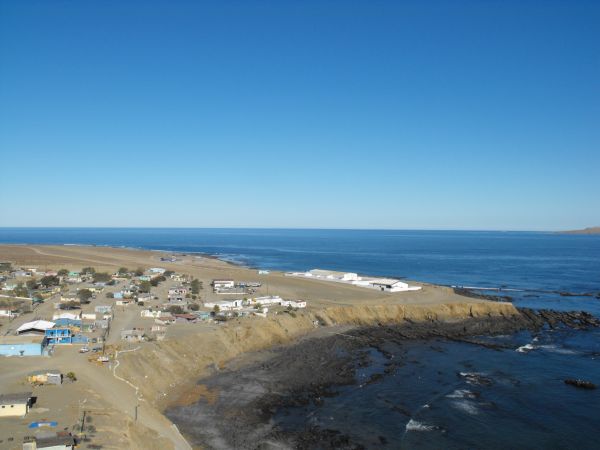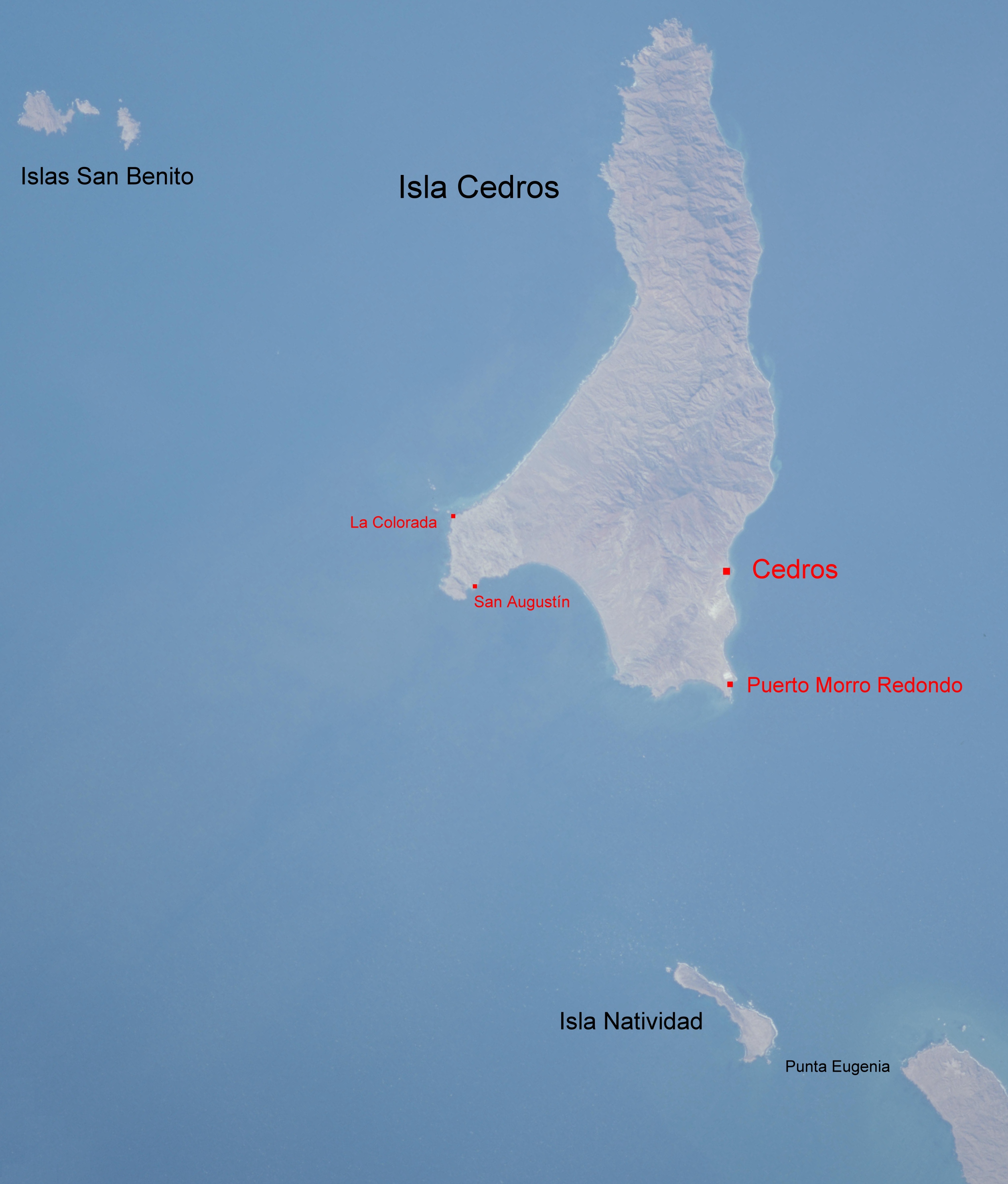Isla Natividad on:
[Wikipedia]
[Google]
[Amazon]

 Isla Natividad is an
Isla Natividad is an
Conservación de Islas website
Islands of Baja California Sur Mulegé Municipality

 Isla Natividad is an
Isla Natividad is an island
An island (or isle) is an isolated piece of habitat that is surrounded by a dramatically different habitat, such as water. Very small islands such as emergent land features on atolls can be called islets, skerries, cays or keys. An island ...
in the Pacific Ocean
The Pacific Ocean is the largest and deepest of Earth's five oceanic divisions. It extends from the Arctic Ocean in the north to the Southern Ocean (or, depending on definition, to Antarctica) in the south, and is bounded by the contin ...
6 km west off Punta Eugenia
Punta Eugenia is a headland in the Mulegé Municipality. It marks the Western tip of the Vizcaíno Peninsula, thus being the westernmost point on the mainland of the state of Baja California Sur. It belongs to the larger area of El Vizcaíno Bio ...
, the northwestern headland of the Mexican state of Baja California Sur. 200 meters off its northwestern end lies Roca María at , with an area of 0.074 km2. Isla Natividad is separated from the mainland at Punta Eugenia by Canal de Dewey (Dewey's Channel), and from Cedros Island
Cedros Island (''Isla de Cedros'', "island of cedars" in Spanish) is an island in the Pacific Ocean belonging to the state of Baja California, Mexico. The dry and rocky island had a population of 1,350 in 2005 and has an area of which include ...
(Baja California
Baja California (; 'Lower California'), officially the Free and Sovereign State of Baja California ( es, Estado Libre y Soberano de Baja California), is a state in Mexico. It is the northernmost and westernmost of the 32 federal entities of Mex ...
), which is 15 km to the north, by Canal de Keller (Canal Kellett).
The island is part of Bahía Tortugas
Baja California Sur (; 'South Lower California'), officially the Free and Sovereign State of Baja California Sur ( es, Estado Libre y Soberano de Baja California Sur), is the least populated state and the 31st admitted state of the 32 federal ent ...
''delegación'' of Mulegé municipality
Mulegé is a city in Mulegé Municipality, Baja California Sur, situated on the Gulf of California. Located on the Gulf of California, the population was 3,821 according to the Mexican census of 2010.
History
Indigenous peoples had lived in ...
. It is 8.655 km2 in area. At the 2001 census, the island had a population of 384, centered in Natividad, a community of abalone, lobster, and clam
Clam is a common name for several kinds of bivalve molluscs. The word is often applied only to those that are edible and live as infauna, spending most of their lives halfway buried in the sand of the seafloor or riverbeds. Clams have two shel ...
fishermen, at the southeastern end (). Connection to the mainland is facilitated by an airstrip
An aerodrome ( Commonwealth English) or airdrome (American English) is a location from which aircraft flight operations take place, regardless of whether they involve air cargo, passengers, or neither, and regardless of whether it is for pub ...
. There is a lighthouse in the northern part.
Geography and ecology
It has steep rocky shores fringed by rocks andkelp
Kelps are large brown algae seaweeds that make up the order Laminariales. There are about 30 different genera. Despite its appearance, kelp is not a plant - it is a heterokont, a completely unrelated group of organisms.
Kelp grows in "underwa ...
except for a small sandy beach towards the mainland. The island is barren and hilly with a peak 150 m high rising near its center. The flora
Flora is all the plant life present in a particular region or time, generally the naturally occurring (indigenous (ecology), indigenous) native plant, native plants. Sometimes bacteria and fungi are also referred to as flora, as in the terms '' ...
consists mainly of a dense cover of ''Mesembryanthemum crystallinum
''Mesembryanthemum crystallinum'' is a prostrate succulent plant native to Africa, Sinai and southern Europe, and naturalized in the New World. The plant is covered with large, glistening bladder cells or water vesicles, reflected in its common ...
'' and '' M. nodiflorum'', cacti, and small shrubs. There are no endemic
Endemism is the state of a species being found in a single defined geographic location, such as an island, state, nation, country or other defined zone; organisms that are indigenous to a place are not endemic to it if they are also found else ...
plants or animals on Natividad due to its proximity to the mainland (it was probably part of the mainland several times during the ice age
An ice age is a long period of reduction in the temperature of Earth's surface and atmosphere, resulting in the presence or expansion of continental and polar ice sheets and alpine glaciers. Earth's climate alternates between ice ages and gre ...
s, when sea level
Mean sea level (MSL, often shortened to sea level) is an average surface level of one or more among Earth's coastal bodies of water from which heights such as elevation may be measured. The global MSL is a type of vertical datuma standardise ...
s were lower). However, '' Mammillaria pondii'' and a little-researched Opuntioideae
Opuntioideae is a subfamily of the cactus family, Cactaceae. It contains 15 genera divided into five tribes. The subfamily encompasses roughly 220–250 species, and is geographically distributed throughout the New World from Canada, to Argentina ...
cactus, as well as ''Mentzelia hirsutissima'' var. ''nesiotes'' are found in few other places. Native land vertebrate
Vertebrates () comprise all animal taxa within the subphylum Vertebrata () (chordates with backbones), including all mammals, birds, reptiles, amphibians, and fish. Vertebrates represent the overwhelming majority of the phylum Chordata, with c ...
s are few, including the deer mouse
''Peromyscus'' is a genus of rodents. They are commonly referred to as deer mice or deermice, not to be confused with the chevrotain or "mouse deer". They are New World mice only distantly related to the common house and laboratory mouse, ''Mu ...
''Peromyscus maniculatus
''Peromyscus maniculatus'' is a rodent native to eastern North America. It is most commonly called the eastern deer mouse; when formerly grouped with the western deer mouse (''P. sonoriensis''), it was referred to as the North American deermou ...
'' and some lizards. Seabird
Seabirds (also known as marine birds) are birds that are adapted to life within the marine environment. While seabirds vary greatly in lifestyle, behaviour and physiology, they often exhibit striking convergent evolution, as the same enviro ...
s – namely Brandt's cormorant – and seals use the island as a breeding and resting site. Isla Natividad is one of the southernmost breeding locations of Cassin's auklet
Cassin's auklet (''Ptychoramphus aleuticus'') is a small, chunky seabird that ranges widely in the North Pacific. It is the only species placed in the genus ''Ptychoramphus''. It nests in small burrows and because of its presence on well studied ...
and a main breeding site for black-vented shearwater
The black-vented shearwater (''Puffinus opisthomelas'') is a species of seabird. The bird is 30–38 cm in length with a 76–89 cm wingspan. Formerly considered a subspecies of the Manx shearwater, its actual taxonomic relationship ...
s.
Restoration
Between 1997 and 2001, Conservacion de Islas removed introduced goat, ''Capra hircus'', domestic sheep ''Ovis aries'', domestic cats ''Felis catus'', domestic dog ''Canis familiaris'', from the island to primarily benefit the black-vented shearwater ''Puffinus opisthomelas''.References
{{coord, 27, 52, 33, N, 115, 11, 05, W, type:isle_source:dewiki, display=titleExternal links
Conservación de Islas website
Islands of Baja California Sur Mulegé Municipality